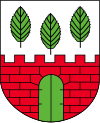
Alternate names: Grabów [Pol], Grabova [Yid], Grabuv [Rus], Russian: Грабув. גראבוב-Hebrew. 52°08' N, 19°01' E, 33 miles NW of Łódź, 10 miles NE of Łęczyca. 1900 Jewish population: 640. Słownik Geograficzny Królestwa Polskiego (1880-1902), II, p. 772: "Grabów" #6. Grabów is a village in Łęczyca County, Łódź Voivodeship, in central Poland and the seat of the administrative district called Gmina Grabów.The village has a population of 1,300.By 1900, the Jewish community had grown to about numbered 640 (61%). When the Germans invaded, the population had significantly decreased, but refugees, t increased he Jewish population to over 1,200 by early 1941. In April, 1942, all remaining Jews were deported to Chelmno. [May 2009]
US Commission No. POCE000692
Grabow is located in the voivodship of Konin at 52º07 19º01, 16 km from the town of Laczyca. The address of the cemetery is Grabow Kolonia. Present town population is 1,350 people with no Jews.
- Local: Andrezej Jastrzebski, Urzad Gminy, ul 1 Maja 5, tel.#: 124. Interested: Kazimerz Soja, ul. Mickiewicza and Boleslow Wierzchowski, Przedrynek, Grabow.
- Regional: Irena Sobierajska, PSOZ-Konin-Posada, Tel. 975, ext. 212-936.
The earliest known Jewish community was 17th century. Pre-WWII Jewish population was about 400 people. The date the Jewish cemetery was established is unknown but both the Orthodox and the Progressive/Reform Jews used it The isolated suburban flat land between fields and woods has no sign or marker. Reached by turning directly off a public road, access is open to all with no wall or gate. The cemetery is 1.5 ha. before and after World War II. There is one granite finely smoothed and inscribed gravestone visible in the cemetery. The municipality owns property is barren. Adjacent properties are agricultural. Local residents rarely visit the cemetery was vandalized during World War II with no maintenance, caretaker, or structures. Moderate threats are security, weather erosion and pollution. Vegetation prevents access seasonally.
Powlicko Nowok, 62510 Vohin 111 distopado 15/76, tel. (1?)434356 [see Konin] completed this survey November 28, 1992. Historical materials and documentation were reviewed at PSOZ. He visited the cemetery on November 28, 1991. While Powlicko Interviewed people for the survey, the interviews were unsatisfactory.
US Commission No. POCE000474
Grabow is located in region Kaliski at 51º31 18º07, 94 km WSW from Lodz. The cemetery is near the filling station at the road to Ostrow, 2-3 km from the town center. Present town population is between 1,000-5,000 people with no Jews.
- Local: Urzad Miasta i Gminy, 8 Kolejowa Street, tel. 63-520 Grabow.
- Regional: PSOZ- WKZ ul Frauciszkauska 3/5; 62-800 Kalisz.
The earliest known Jewish community early 18th century. 1905 Progressive/Reform Jewish population was 101. The isolated unlandmarked crown of a hill, between fields and woods, has no sign or marker. Reached by turning directly off a public road, access is open to all with no wall or gate. 1-20 gravestones are in original location. The stones removed from the cemetery were probably used to build the water dam. Those that remain are made of sandstone flat shaped stones or multi-stone monuments. There are no known mass graves. Within the cemetery are fragmentary remains of the steps in front of the former entrance. The municipality owns unused property. Adjacent properties are commercial (filling station) and agricultural. The site is never visited. The cemetery was vandalized during World War II with no maintenance since the war. There is no caretaker. Current moderate threats are security and vandalism. Vegetation overgrowth a serious threat, a constant problem that disturbs both graves and tombstones.
Michal Witwicki, Dembocoswiego 12/53, 02-J84 Watszawa, tel. 6418345 completed this survey on October 29, 1991. He visited the cemetery with Eleoura Rergowiau on October 18, 1991.
